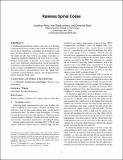Rateless spinal codes
Author(s)
Perry, Jonathan; Balakrishnan, Hari; Shah, Devavrat
DownloadhotnetsX-final32.pdf (257.4Kb)
OPEN_ACCESS_POLICY
Open Access Policy
Creative Commons Attribution-Noncommercial-Share Alike
Terms of use
Metadata
Show full item recordAbstract
A fundamental problem in wireless networks is to develop communication protocols that achieve high throughput in the face of noise, interference, and fading, all of which vary with time. An ideal solution is a rateless wireless system, in which the sender encodes data without any explicit estimation or adaptation, implicitly adapting to the level of noise or interference. In this paper, we present a novel rateless code, the spinal code, which uses a hash function over the message bits to produce pseudo-random bits that in turn can be mapped directly to a dense constellation for transmission. Results from theoretical analysis and simulations show that spinal codes essentially achieve Shannon capacity, and out-perform best-known fixed rate block codes.
Date issued
2011Department
Massachusetts Institute of Technology. Department of Electrical Engineering and Computer ScienceJournal
Proceedings of the 10th ACM Workshop on Hot Topics in Networks (HotNets-X)
Publisher
Association for Computing Machinery (ACM)
Citation
Jonathan Perry, Hari Balakrishnan, and Devavrat Shah. 2011. Rateless spinal codes. In Proceedings of the 10th ACM Workshop on Hot Topics in Networks (HotNets-X). ACM, New York, NY, USA, , Article 6 , 6 pages.
Version: Author's final manuscript
ISBN
9781450310598